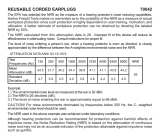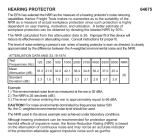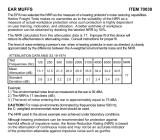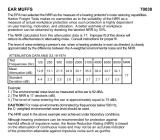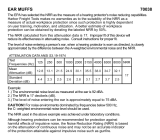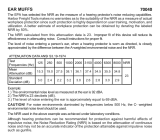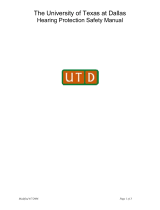
E•A•RLog® is a registered trademark of Aearo Company. Copyright 2000. First printing 1993
LIT. CODE 30314 2/99AG
If it is not well fitted, or left partially ajar, or
circumvented by an inconvenienced
employee, or its gaskets and seals age,
deteriorate, or break, then its perfor-
mance will be degraded in a manner
similar to that observed for poorly fitted
and misused HPDs. Likewise, an em-
ployee may complain, "I can't hear my
machine when I wear these earmuffs,"
but in terms of noise reduction and
change in sound quality, there is little
difference between putting the box on
the employees head (e.g. donning an
earmuff), or putting the box around the
machine.
Most engineering control procedures,
except for some source noise control
accomplished through equipment rede-
sign, required maintenance and periodic
adjustment or replacement to remain
effective. Furthermore, except for enclo-
sures, retrofit noise reductions of 10 dB
or more are often difficult to achieve and
maintain. Thus HPDs can be, and often
are, required as an effective adjunct to
engineering controls in the majority of
industrial noise environments.
Recommendations
Existing North American hearing protec-
tor attenuation data and the associated
labeled NRRs provide a very poor indi-
cator of the protection that will typically
be achieved by the majority of employ-
ees in industrial and military hearing
conservation programs. Efforts must be
expended to develop more realistic stan-
dardized testing procedures so that pub-
lished attenuation values can provide
useful estimates of actual protection. In
fact, such work is currently underway.
6
Meanwhile, labeled NRRs must be der-
ated. A 50% derating such as OSHA re-
quires for evaluation of relative perfor-
mance, is justifiable in order to reduce
the existing NRRs from the unattainable
to the achievable. Furthermore, treating
earplugs and earmuffs differentially (i.e.
a somewhat larger derating for earplugs)
may be warranted. However, protector
brand-specific deratings are premature
until additional real-world attenuation
results become available.
Rather than relying upon labeled NRRs
in selecting HPDs, factors that should
be considered are comfort, field attenu-
ation, human engineering, compatibil-
ity, durability, cost, styling and availabil-
ity. It is not possible to rank order these
items in a manner suitable for all appli-
cations, but most would agree that com-
fort and field attenuation should be
weighed most heavily. General esti-
mates of attenuation can be gleaned from
data such as provided in Fig. 1.
The practice of purchasing only HPDs
that will meet the highest noise attenua-
tion requirements within a plant, on the
presumption that control of HPD usage
is impossible and therefore any device
which is purchased may end up being
used anywhere within the plant, should
be discouraged. Instead HPDs should
be approximately matched to the noise
exposure requirements of groups of simi-
larly-exposed individuals, and control of
usage within the plant should become
part of the educational process.
For the majority of industrial noise expo-
sures, those up to equivalent eight-hour
levels of about 95 dBA, 10 dB of actual
delivered on-the-job protection is all that
is necessary. Most conventional hearing
protectors, when properly sized and fit-
ted, and consistently worn, can fulfill that
requirement. As the sound levels in-
crease so that exposures exceed 95
dBA, choices should be limited to the
more protective devices. These have
been shown to be foam earplugs and
most earmuffs (as indicated in Fig. 1), or
a combination of the two.
The hearing protector selection process
should consist of more than merely scan-
ning manufacturers' specification sheets
and price lists. Wear test the products
you intend to use, both on yourself (for
extended periods of a few hours or more)
and on small groups of employees. By
developing your own firsthand knowl-
edge and combining it with employee
feedback, you not only improve the like-
lihood of selecting products your em-
ployees will accept, but you also will
better motivate your workers by involv-
ing them in their own hearing conserva-
tion program.
References
1. ANSI (1974). "Method for the Measurement of Real-Ear
Protection of Hearing Protectors and Physical Attenuation of
Earmuffs," Am. Natl. Stds. Inst., S3.19-1974, New York, NY.
2. ANSI (1984). "Method for the Measurements of the Real-Ear
Attenuation of Hearing Protectors," Am. Natl. Stds. Inst.,
S12.6-1984, New York, NY.
3. Berger, E.H. (1979-1992). EARLog Series, #1 - #20. Aearo
Company, Indpls., IN.
4. Berger, E.H. (1983). "Using the NRR to Estimate the Real-
World Performance of HPDs,"S&V 17(1), 12-18.
5. Berger, E.H. (1988). "Can Real-World Hearing Protector
Attenuation Be Estimated Using Laboratory Data?", S&V
22(12) 26-31.
6. Berger, E.H. (1992). "Development of a Laboratory Procedure
for Estimation of the Field Performance of Hearing
Protectors", in
Proc., 1992 Hearing Conservation
Conference
, Off. Eng. Serv., Lexington, KY, 41-45.
7. Berger, E.H ., Franks, J.R., and Lindgren, F. (1996).
“International Review of Field Studies of HPD Atten.,” In
Scientific Basis of NIHL,
eds. Axlesson, et al., Thieme Med.
Pub., New York, NY. 361-377.
8. Berger, E.H., Kerivan, J.E., and Mintz, F. (1982). "Inter-
Laboratory Variability in the Measurement of Hearing
Protector Attenuation", S&V 16(1), 14-19.
9. EPA (1979). "Noise Labeling Requirements for Hearing
Protectors", Fed. Regist. 44(190), 40CFRPart 211, 56130-
56147.
10. ISO (1992). "Acoustics - Hearing Protectors - Part 2;
Estimation of Effective A- Weighted Sound Pressure Levels
When Hearing Protectors Are Worn", Int. Org. for Std., ISO/
DIS 4869-2.2, Switzer land.
11. Lundin, R. (1992). "Properties of Hearing Protector Rating
Methods",
Proc., 1992 Hearing Conservation Conference
.
Off. Eng. Serv., Lexington, KY, 55-60.
12. OSHA (1981). "Occup. Noise Exposure; Hearing Cons.
Amend.," Fed. Regist. 46(11), 4078-4181.
13. OSHA (1983). "Occup. Noise Exposure; Hearing Cons.
Amend.,"Fed. Regist. 48(46), 9738-9785.
14. OSHA (1992). "Instruction CPL 2.45B, June 15", Field
Operations Manual, 5th Ed., Gov. Inst., Inc., Rockville, MD,
p. IV-33 - IV-36.
15. OSHA (1990). "Instruction CPL 2-2.20B, Feb. 5,"Industrial
Hygiene Technical Manual, Gov. Inst., Inc., Rockville, MD,
p.4-1 - 4-15
16. Royster, L.H., Royster, J.D., and Cecich, T.F. (1984). "Eval.
of the Effectiveness of Three HPDs at an Indust. Facility
with a TWA of 107 dB", JASA 76 (2), 485-497.
Table I - Application of OSHA - specified computation for an HPD with a
labeled NRR of 21 dB
EXAMPLE: Unprotected Time-Weighted Average (TWA) exposure = 100 dBA.
To assess ADEQUACY per Appendix B, the protected TWA is computed as:
100 dBA - 14 = 86 dBA, current hearing protection is legally adequate.
To assess RELATIVE PERFORMANCE, i.e. comparison of field attenuation to engineering or
administrative controls, the protected TWA is computed as: 100 dBA - 7 dB = 93 dBA;
since this exceeds 90 dBA, feasible engineering controls must be implemented.
NOTE: when using muffs and plugs together, OSHA adds 5dB to NRR of higher-rated HPD. For field
effectiveness, 5dB is addd after 50% adjustment, as in:
NRR
plug
= 29; NRR
muff
= 21; field NRR for use with dBA = [(29 - 7)/2] + 5 = 16 dB.
ADEQUACY per hearing Cons.
Amendment, Appendix B
RELATIVE PERFORMANCE
vs. noise controls
NRR for use with
dBC measurements
21
21 / 2 = 10.5
NRR for use with
dBA measurements
21 - 7 = 14
(21 - 7) / 2 = 7




